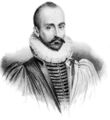Template:Selected anniversaries/September 13: Difference between revisions
No edit summary |
No edit summary |
||
| Line 31: | Line 31: | ||
File:The Governess.jpg|link=The Governess|1900: Social activist and alleged superhero [[The Governess]] shames [[math criminals]] into returning stolen digits, paying compensation for lost computational power, and personally apologizing to everyone who was inconvenienced by this sorry episode of bad behavior, ''which will never be repeated.'' | File:The Governess.jpg|link=The Governess|1900: Social activist and alleged superhero [[The Governess]] shames [[math criminals]] into returning stolen digits, paying compensation for lost computational power, and personally apologizing to everyone who was inconvenienced by this sorry episode of bad behavior, ''which will never be repeated.'' | ||
||1905: Michael Willcox Perrin born ... scientist who created the first practical polythene, directed the first British atomic bomb programme, and participated in the Allied intelligence of the Nazi atomic bomb. Pic. | |||
||1912: Horace W. Babcock born ... astronomer, son of Harold Babcock. Working together, they were the first to measure the distribution of magnetic fields over the surface of the Sun. Horace invented and built many astronomical instruments, including a ruling engine which produced excellent diffraction gratings, the solar magnetograph, and microphotometers, automatic guiders, and exposure meters for the 100 and 200-inch telescopes. By combining his polarizing analyzer with the spectrograph he discovered magnetic fields in other stars. He developed important models of sunspots and their magnetism, and was the first to propose adaptive optics (1953). Pic: https://aas.org/obituaries/horace-welcome-babcock-1912-2003 | ||1912: Horace W. Babcock born ... astronomer, son of Harold Babcock. Working together, they were the first to measure the distribution of magnetic fields over the surface of the Sun. Horace invented and built many astronomical instruments, including a ruling engine which produced excellent diffraction gratings, the solar magnetograph, and microphotometers, automatic guiders, and exposure meters for the 100 and 200-inch telescopes. By combining his polarizing analyzer with the spectrograph he discovered magnetic fields in other stars. He developed important models of sunspots and their magnetism, and was the first to propose adaptive optics (1953). Pic: https://aas.org/obituaries/horace-welcome-babcock-1912-2003 | ||
Revision as of 06:17, 30 December 2019
1592: Philosopher and author Michel de Montaigne dies. He was one of the most significant philosophers of the French Renaissance, known for popularizing the essay as a literary genre.
1700: Mathematician, astronomer, and criminal investigator Giovanni Domenico Cassini publishes new study of the division of the rings of Saturn which reveals a series of previously unknown crimes against astronomical constants. This study will influence a generation of crime-fighting astronomers, leading to numerous breakthroughs in scientific law enforcement.
1861: Mathematician Dmitry Mirimanoff born. In 1917, he will introduce the cumulative hierarchy of sets and the notion of von Neumann ordinals; although he will introduce a notion of regular (and well-founded set) he will not consider regularity as an axiom, but also explore what is now called non-well-founded set theory, and the idea of what is now called bisimulation.
1873: Mathematician and author Constantin Carathéodory born. He will pioneer the axiomatic formulation of thermodynamics along a purely geometrical approach.
1898: Priest and inventor Hannibal Goodwin patents celluloid photographic film.
1900: Social activist and alleged superhero The Governess shames math criminals into returning stolen digits, paying compensation for lost computational power, and personally apologizing to everyone who was inconvenienced by this sorry episode of bad behavior, which will never be repeated.
2013: Army research laboratories convert modern plowshares into ancient swords. Military contractors call technique "Astonishing breakthrough."
2016: Steganographic analysis of Green Ring 2 reveals "over two hundred kilobytes" of previously unknown Gnomon algorithm functions.






